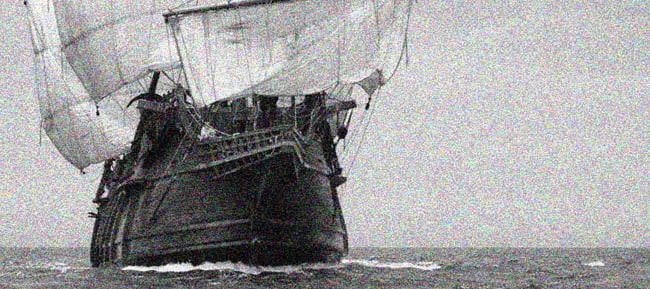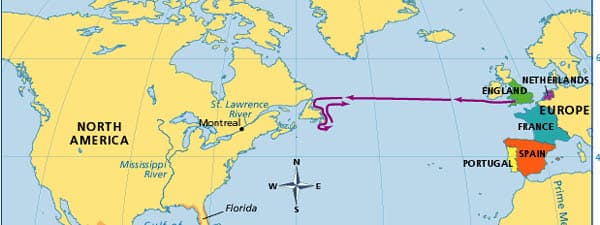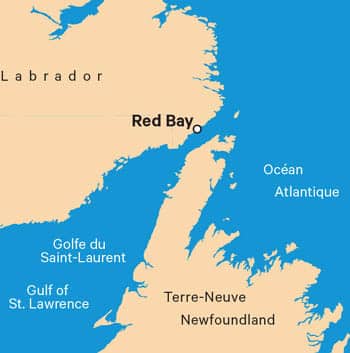Part One: Commodity Cod and Factory Ships
Part Three: The First Cod War
Part Four: The Fishing Revolution

“In the sixteenth and partly still in the seventeenth, the sudden expansion of trade and the creation of a new world market had an overwhelming influence on the defeat of the old mode of production and the rise of the capitalist mode.” — Karl Marx[1]
by Ian Angus
Accounts of transatlantic trade in the 1500s typically focus on what Perry Anderson calls “the most spectacular single act in the primitive accumulation of European capital during the Renaissance” — the plunder of precious metals by Spanish invaders in South and Central America.[2] Year after year, well-guarded convoys carried gold and silver to Europe, simultaneously enriching Spain’s absolute monarchy and destabilizing Europe’s economy.
Spain’s treasure fleets certainly played a big role in the long-term development of European capitalism, but they were not alone in creating a disruptive transatlantic economy. While Spanish ships carried silver and gold, a parallel trade involving far more ships developed far to the north. Historians of capitalism, including Marxists, have paid too little attention to what Francis Bacon called “the Gold Mines of the Newfoundland Fishery, of which there is none so rich.”[3]
‘Swarming with fish’
Remarkably little is known about the Venetian navigator who sailed from England to North America in 1497. His real name was Zuan Cabotto, but he was known as Juan Caboto in Spain and John Cabot in England. In 1496, Henry VII granted him letters patent “to find, discover and investigate whatsoever islands, countries, regions or provinces of heathens and infidels, in whatsoever part of the world placed, which before this time were unknown to all Christians.”[4] With financial backing from Italian bankers and merchants from the west England port of Bristol, he sailed west on May 2, 1497, in a small ship with about 18 crew.[5] Thirty-five days later, he “discovered” new territory on the far side of the Atlantic.

Cabot’s first voyage to Newfoundland, 1497. (Approximate: no one knows for sure.)
Of course, the large island that became known as Newfoundland had been discovered long before: there is evidence of human settlement on the island nine thousand years ago, and the Beothuk people had been there for 1500 years when Cabot claimed it for the English king and the Catholic Church. Cabot wasn’t even the first European — Viking explorers briefly settled in Newfoundland around 1000 CE, and it is possible that Basque and Portuguese fishers sailed to the cod-rich waters earlier in the 1400s. Nevertheless, Cabot’s rediscovery of Newfoundland is important to the history of capitalism, because it alerted Europe’s fast-growing merchant class to a major opportunity to profit by expropriating nature’s free gifts.
Like Columbus, John Cabot was seeking a direct route to Asia — as historian Peter Pope writes, he “sought Japan, but his greatest discovery was cod.”[6] Shortly after the Matthew returned to Bristol in August 1497, the Milanese ambassador in London wrote to the Duke of Milan:
“They assert that the Sea there is swarming with fish which can be taken not only with the net but in baskets let down with a stone, so that it sinks in the water. I have heard this Messer Zoane [Cabot] state so much. These same English, his companions, say that they could bring so many fish that this Kingdom would have no further need of Iceland, from which there comes a very great quantity of the fish called stockfish.”[7]
Gold rush
Within a decade of Cabot’s return, fishing “opened up in Newfoundland with the enthusiasm of a gold rush.”[8] By 1510, dozens of ships from France, Spain and Portugal were travelling to the land of cod every spring, and by mid-century there were hundreds. The Newfoundland fishery drove “a 15-fold increase in cod supplies … [and] tripled overall supplies of fish (herring and cod) protein to the European market.”[9] Cod, formerly a distant second to herring, comprised 60% of all fish eaten in Europe by the late sixteenth century.[10]
Some accounts of early modern fishing give the impression that Newfoundland cod were caught by brave independent fishers who crossed the Atlantic in tiny boats. A few may have done that, but not enough to a cause the immense leap in commodity fish production that historians have dubbed the North Atlantic Fish Revolution. That was accomplished by thousands of skilled fishworkers who crossed the ocean in large ships that were financed by merchant capitalists. Transatlantic fishing was big business from the beginning.
Beginning in the 1500s, the Newfoundland fishery developed in two main forms that continued for centuries.
- Inshore: Most fishers targeted the cod that come near land to prey on smaller fish each summer. The fish were caught from small open boats and taken ashore every day for processing.
- Offshore: Late in the century, French ships began working the Grand Banks, a large, relatively shallow area that extends about 300 kilometers (200 miles) south and east of Newfoundland, where cod gather to spawn. The fish were caught and preserved on the ships, eliminating frequent trips to shore.
Both fisheries developed factory-like operations, with a structured division of labor between workers skilled in the various tasks of catching and preparing fish.
The offshore fishery caught and preserved fish on ships similar to the Dutch herring busses described in Part One. In each ship, up to 20 men worked long days in production lines. The cod were caught by fishers, each working several baited lines at once. Preparers beheaded, gutted, split, and deboned the fish. Particularly valuable parts such as the liver were set aside, and the rest of the animal was heavily salted and stacked in the ship’s hold. When the hold was full of what was called wet or green (actually pickled) cod, the ship returned to Europe. Some made two or three roundtrips each year.
Inshore operations involved more ships and workers, but were more time-limited, because the best inshore fishing occurred from June to August, when millions of capelin (a small smelt-like fish) spawn in shallow waters, attracting hungry cod.[11]
Each spring, cargo ships travelled from western Europe to bays and inlets along the Newfoundland coast. Each ship carried up to 150 workers, many barrels of salt, and a dozen or so open fishing boats that had been built in Europe, then disassembled for compact storage. Long beaches known for particularly good fishing attracted multiple ships, so some seasonal fishing camps housed thousands of workers at a time.
After landing in May or early June, the workers assembled their boats and built wharves, sleeping huts, work sheds, and outdoor drying racks. As on the offshore ships, there was a factory-like division of labor. Three or four men rowed out in each small boat every morning. When a boat was full — each could hold hundreds of fish — it returned to shore, where skilled workers beheaded, gutted, split, and deboned the cod. Summers in Newfoundland were too warm for the Norwegian method of freeze-drying, so the fish was lightly salted before being laid out in the sun and turned frequently for several weeks. The result, known as salt-cod or Poor John, was tastier than Norwegian stockfish, and largely replaced it as the leading mass-produced food commodity in England and southern Europe.
The cod were so plentiful that often more were caught and dried than one ship could carry, so an intermediate trade developed in which Dutch merchants on sack ships purchased dried fish from Newfoundland beaches during the season and resold it in Europe.
Through the 16th century, cod fishing was concentrated on Newfoundland’s east and south coasts. A different extractive industry developed near the island’s northwest corner.
The world’s first oil boom
In the 1970s, Selma Huxley Barkham radically changed our understanding of the 16th century fishery in Newfoundland and Labrador. With little institutional support — she taught English part-time to pay her bills — the Canadian archivist spent years in northern Spain, digging through libraries and archives in search of references to 16th century Basque voyages to Terranova. Her discoveries rewrote the history of sixteenth century Newfoundland: she found convincing evidence that in addition to the thousands of men who came for cod, up to 2,000 Basque whalers spent each year in the area now known as the Strait of Belle Isle, between the island’s northern peninsula and the Labrador mainland. Following her leads, archaeologists have found several sunken ships and the remains of over a dozen 16th century whaling stations on the Labrador shore.
Basques from France and Spain had dominated commercial whaling in Europe for five hundred years. Hunting in the Bay of Biscay, they primarily targeted bowhead and right whales, which were large — up to 17 meters long — but much smaller than the animals that deep-sea whalers later hunted to near-extinction. Rights and bowheads were slower, and — a major advantage to the rowers who had to tow them ashore — they remained afloat when killed.
Basque merchants sold salted whale meat, which could be eaten on holy days because the whales were thought to be fish, and baleen, a flexible cartilage that was used to make corsets, buggy whips, umbrellas and such. But the big money maker was whale oil, produced by slowly heating blubber in large cauldrons. Barrels of Basque whale oil were used as far away as England and Germany for textile manufacturing, lighting, soap-making, and caulking ships.[12]

Red Bay, on the Strait of Belle Isle, was the site of the largest Basque whaling station in the 16th Century.
At some point, probably about 1530, Basque fishers discovered that each summer and autumn bowhead whales migrated in large numbers through the Strait of Belle Isle, where they could be caught relatively easily.[13] Intensive whale hunts soon began, with hundreds of teams of Basque whalers travelling annually to the Strait in “ships as large as anything afloat … some of them were capable of carrying up to two thousand barrels of whale oil, which weighed three hundred pounds each.”[14] For four to six months each year they lived and worked in whaling stations that were similar to the temporary cod fishing villages, with a major exception: instead of drying racks they built tryworks — rows of large stone ovens sheltered by tile roofs, where blubber was boiled down.
Whaling was dangerous work for the men and brutal for the whales. When whales were sighted from shore, several teams set out in chalupas — 8-meter long open boats — each crewed by a harpooner, a steersman and four or five oarsmen. Archaeologist James Tuck describes the usual method of attack:
“Whales were approached by rowing the boats to within as close as a meter, at which point the whale was harpooned with a barbed iron harpoon .… [on a rope that was attached] to a “drogue” or drag which the whale towed through the water until it tired…. Often several harpoons were thrust into the same whale and even then the chase might have taken hours and covered miles before the whale could be approached safely and killed by repeated thrusts of a razor-sharp lance. … Once the whale was killed it was towed by several boats — often against tide and wind — to one of the shore stations for processing.”[15]
On shore, flensers (whale butchers) removed the whale’s blubber in long spiral strips and cut it into thin pieces. Tryers heated the blubber slowly in copper cauldrons, controlling the temperature to avoid burning, and periodically skimming off oil and moving it to cooling pots, a process that required days of constant attention and work. The cooled oil was stored in 200-liter barrels that coopers assembled onsite.
Barkham’s research showed that whaling operations in the Strait of Belle Isle were “a resounding financial success from their inception.” She estimated that the Basque whalers produced upwards of 15,000 barrels of whale oil each year, and sold most of it on the way home in Bristol, London and Antwerp.[16]
But as so often happens when natural resources become mass commodities, the exploitation of whales in Newfoundland soon undermined the very basis of the industry. It’s obviously impossible to get exact numbers, but an authoritative study estimates that “as many as a third of the western Atlantic bowhead’s pre-hunt numbers were killed during the course of the 16th century.”[17] Bowhead whales reproduce slowly — females take 15 years to reach sexually maturity, and typically they have only one calf every 3 or 4 years — so the removal of a third of the migrating whales in a few decades had devastating effects.[18] By the early 1580s, overhunting had so reduced the bowhead population that some ships returned to Europe half-empty.
Over the next two decades, whalers shifted their hunts west to the Gulf of St. Lawrence and north to the Arctic, and intensive whaling in Newfoundland’s coastal waters ceased for nearly 300 years.
England vs Spain
Declining catches undoubtedly motivated Spanish Basques to hunt elsewhere, but the geographic shift was made more urgent by conflicts on the far side of the Atlantic.
For most of the 1500s, English ships and fishers were a distinct minority in the Newfoundland fishery, but by the end of the century Spanish ships had all but disappeared, and the English presence was growing rapidly. In the 1570s, about 50 English ships travelled to Newfoundland each year; by 1604 the number had tripled.[19] To understand how and why that happened, we must take a brief detour into European geopolitics.
Part 3 of this article will discuss how England replaced Spain in the Newfoundland fishery.
This article is part of my continuing project on metabolic rifts. Your constructive comments, criticisms, and corrections will help me get it right.
Notes
[1] Karl Marx, Capital: Volume III, (Pelican, 1981) 450-1.
[2] Perry Anderson, Lineages of the Absolutist State (London: Verso, 1979), 61.
[3] Quoted in D. W. Prouse, A History of Newfoundland from the English, Colonial and Foreign Records (London: MacMillan & Co., 1895), 54.
[4] “First Letters Patent granted by Henry VII to John Cabot , 5 March 1496,” The Smugglers’ City, Department of History, University of Bristol.
[5] By comparison, five years earlier Columbus had sailed from Spain with three ships and a crew of 86.
[6] Peter E. Pope, The Many Landfalls of John Cabot (University of Toronto Press, 1997), 176.
[7] Quoted in Callum Roberts, The Unnatural History of the Sea (Washington: Island Press, 2007), 33. Stockfish was dried cod.
[8] Mark Kurlansky, Cod: A Biography of the Fish That Changed the World (New York: Walker Publishing, 1997), 51.
[9] Poul Holm et al., “The North Atlantic Fish Revolution (ca. AD 1500),” Quaternary Research, 2019, 2.
[10] Kurlansky, Cod, 51.
[11] Although the cod are gone and capelin stocks are much reduced, the annual “capelin roll” still attracts large numbers of seabirds, whales, and tourists to beaches in Newfoundland and Labrador. The fish swim close to the beach, where they can be easily caught in small nets or even buckets.
[12] Brad Loewen, “Historical Data on the Impact of 16th-Century Basque Whaling on Right and Bowhead Whales in the Western North Atlantic,” Canadian Zooarchaeology, no. 26 (2009): 4.
[13] Until recently, historians believed that Basque whalers caught right whales in summer and bowhead whales in autumn, but DNA analysis of whalebones shows that bowheads made up almost the entire catch. B. Mcleod et al., “Bowhead Whales, and Not Right Whales, Were the Primary Target of 16th- to 17th-century Basque Whalers in the Western North Atlantic,” Arctic 61, no. 1 (March 2008), 61-75.
[14] Frederick W. Rowe, A History of Newfoundland and Labrador (Toronto: McGraw-Hill Ryerson, 1980), 46.
[15] James A. Tuck, “The World’s First Oil Boom,” Archaeology 40, no. 1 (Jan.-Feb. 1987), 51.
[16] Selma Huxley Barkham, “The Basque Whaling Establishments in Labrador 1536-1632 — A Summary,” Arctic 37, no. 4 (December 1984), 518.
[17] Loewen, “Historical Data,” 15.
[18] The population impact was increased by the common practice of targeting mother-calf pairs: the calf was easy to kill, and the mother could then be harpooned when she approached to save her child.
[19] Gillian T. Cell, English Enterprise in Newfoundland, 1577-1660 (University of Toronto Press, 1969), 602, Kindle.



Many thanks for this post. Since reading Part I of the series, I have been eagerly awaiting Part II and it did not disappoint. This topic comes into an essay series I’ve been working on, and your work provides a clear context and answers some critical questions for me. I will read Part 3 with the same anticipation.